5 Challenges in Adapting The Infinity Gauntlet
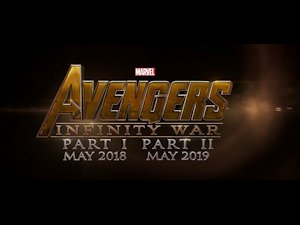 | | Who do I give all my money to? |
With Captain America: Civil War nearing release, the Marvel Cinematic Universe is about to enter Phase Three, the culmination of eight years of unprecedented world-building on the silver screen. Ever since Thanos grinned at audiences during the credits to The Avengers, we've known that one of Marvel's most well-known comic book events, The Infinity Gauntlet, was on the MCU drawing board. A few years back, it was officially confirmed that Thanos' bid for omnipotence would spark not one but two films called Avengers: Infinity War.
This article is going to cover the problems Marvel faces in dealing with The Infinity Gauntlet storyline, but before we begin, let's clear up a little bit of confusion. In the comics, there is an event series called The Infinity War, but it is a direct sequel to The Infinity Gauntlet. For this article, let's work under the assumption that the cinematic Avengers: Infinity War, Part I is an adaptation of The Infinity Gauntlet, the story where Marvel's heroes go up against Thanos after he has acquired the Infinity Gauntlet and all six Infinity Gems, and that Avengers: Infinity War, Part II is an adaptation of The Infinity War, where our heroes must contend with what happens after Adam Warlock acquires the fully assembled gauntlet. Emphasis on assumption, by the way, because this is not confirmed in any way; it just makes a certain logical sense given everything we know so far.
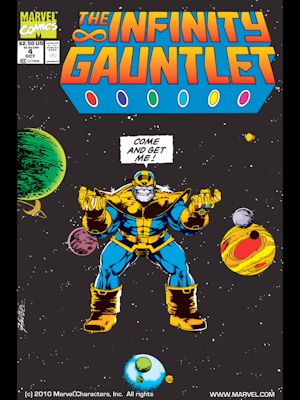 | | Let them fight |
With that disclaimed, let's turn our attention to The Infinity Gauntlet. Spoiler warnings all around, by the way. It begins with Thanos, already in possession of the assembled gauntlet. After a few futile efforts to earn a smile from his unrequited love, Lady Death, by toying with his newfound mastery over all that exists (including resurrecting his granddaughter, Nebula, as a zombie-like husk), he decides that he must obliterate half of all life in the universe with a snap of his fingers. On Earth, Dr. Strange is visited by the Silver Surfer, who tries to warn him of the danger mere moments before people start succumbing to a "great disappearance." Airplanes crash, people panic, and what's left of the Avengers assemble to mount a counterstrike. In steps the enigmatic Adam Warlock, former master of the Soul Gem, with a plan to defeat Thanos once and for all. Our heroes throw everything they have at Thanos to no avail, as outmatched against the Titan as flies to a hurricane. Thanos then fights the cosmic manifestations of existence and becomes the embodiment of reality itself, Eternity, but fails to notice that, at his corporeal body, his half-living granddaughter, Nebula, snatches the gauntlet and claims it as her own. Nebula undoes everything Thanos has done--bringing back the dead and restoring the cosmos--but proves to be just as dangerous with the gauntlet as Thanos could ever be. Adam Warlock then uses his knowledge of the Soul Gem to take control of the gauntlet before Nebula can get a handle on her new powers, and he takes it away, promising to be a fair and neutral arbiter of ultimate power (which, of course, he can't be, hence The Infinity War that follows).
If that sounds like a big, crazy, mind-bending journey, that's because it is. It's the most grandiose comic story that anyone has ever attempted to put on film, and if successful, it will set the standard for a much bigger type of movie than anything we've yet seen. Despite its scope, however, it's a much tighter story than, say, Civil War, a story arc that is covered by nearly a hundred separate comics (whereas The Infinity Gauntlet is contained in just six). It's relatively simple, and would be hard to spread over two movies, not to mention the fact that there is nowhere to cleanly break the story in half. Still, even if they somehow stretch The Infinity Gauntlet across both parts of the cinematic Infinity War (which would be disappointing, because the comic Infinity War is in many ways superior to The Infinity Gauntlet), they absolutely have to adapt it in some form or another. It can't be a direct retelling of the story for many reasons, but most of the problems that arise in trying to fit The Infinity Gauntlet into the existing MCU are relatively simple to fix. Silver Surfer, for example, is utterly unnecessary to the plot, and he could easily be replaced by any existing cosmic character from Guardians of the Galaxy or elsewhere.
Unfortunately, there are some problems that are a bit more prickly:
Death and the Other Cosmic Entities
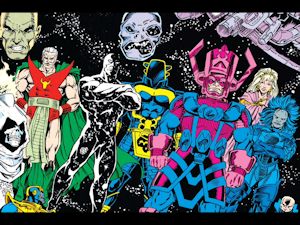 | | They're huge |
We've already covered this recently, but it bears repeating. The Cosmic Entities are a large part of The Infinity Gauntlet, with most of them fighting Thanos during the entirety of the fifth comic in the series. Any film adaptation of the story would feel much smaller without this integral piece, and it's hard to imagine how Marvel could leave the Cosmic Entities out of the equation. Of all of them, however, Death is clearly the most important, because everything Thanos is trying to do is in service to Death, to get her to love him and rule the universe at his side. Without Death, Thanos has no real character arc--he'd be just another generic baddie--and not even the acting chops of Josh Brolin can make him interesting enough to carry an entire movie. However, if you introduce Death and other Cosmic Entities for the first time in Avengers: Infinity War, Part I, it will be too drastic; they must be introduced earlier, which is why I'm still betting on seeing one or more of them introduced in the MCU well in advance, probably in this year's Doctor Strange.
Destruction Overload
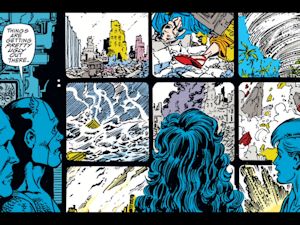 | | CGI can make it beautiful |
We've reached a point now where cataclysmic destruction in movies leaves audiences numb instead of awe-struck. This has been especially true in comic book movies, and it's being addressed directly in Batman v. Superman: Dawn of Justice and Captain America: Civil War. A good chunk of The Infinity Gauntlet, though, involves ludicrous amounts of destruction, the kind that makes the destruction of Metropolis in Man of Steel seem tiny. The entire Earth starts spinning out of orbit, gets racked with massive earthquakes and tidal waves, and sees half its population suffer miserably after the other half blinks out of existence. It's a very thin line between spectacle and CG-soaked ridiculousness Marvel must walk here.
It's One Big Fake-Out
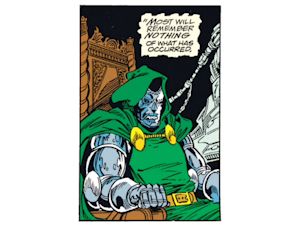 | | If only we could say the same about the Fantastic Four movies |
Then again, all that destruction is neatly undone near the end of the story; none of it ultimately matters. This is very tricky narrative territory, and I can't think of a single movie that has tried this bait-and-switch and succeeded. Superman turning back time is seen as a cop-out, while both Sphere and Prince of Persia: The Sands of Time were outright flops due in large part to their unsatisfying endings. The MCU has been plagued by death fake-outs (Agent Coulson, Pepper Potts, Nick Fury, Bucky Barnes, Loki, Odin, Thor, and Tony Stark have all appeared to die onscreen only to be resurrected miraculously and occasionally unbelievably), which is par for the course in a comic book universe. However, audiences are starting to tire of it, and The Infinity Gauntlet "kills" virtually every character in the entire Marvel universe only to then call "psych!" in the final act. I don't see audiences accepting that unless Marvel addresses this problem beforehand, with major characters being dead and buried well before the war even begins (which is a distinct probability, I'd wager). Also, it should be noted that the movies are being billed as Avengers titles, even though, in the comic storyline, they fail to succeed in anything and are only saved in the end by Nebula and Warlock. Audiences might not like that.
Adam Warlock
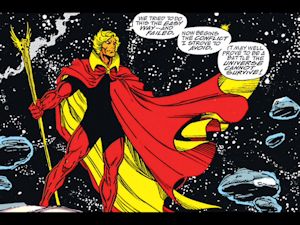 | | His hobbies include dying and sleeping in a coccoon |
If there's a protagonist in The Infinity Gauntlet, it is definitely Adam Warlock. The problem, then, is that he doesn't seem to exist in the MCU, at least not yet. There's an easter egg for him in Guardians of the Galaxy, but audiences unfamiliar with the comics are bound to be confused if they go to see a movie called The Avengers and wind up seeing a movie about a weird orange fellow they've never heard of. Even more troublesome is the possibility that the second half of the cinematic Infinity War will be an adaptation of the comic Infinity War, where Adam Warlock is both the main villain and the main hero (it's complicated). Rumors abound that Warlock may appear in an MCU film to come (the current most popular theory being that Mads Mikkelsen is playing Warlock in Doctor Strange, even though all signs point to him being Modred the Mystic), and with the character inextricably tied to the Soul Gem in the comics, it seems inevitable that he will appear at some point, as the Soul Gem (er, Stone) has yet to appear in the MCU. Then again, it's also possible that Avengers: Age of Ultron laid the groundwork for Vision to take Warlock's place in the story, given that he's got the Mind Stone in his forehead (just as Warlock has the Soul Gem in his) and is powerful and smart enough to play master strategist against Thanos. It's also possible, though less likely, that Dr. Strange will take Warlock's place.
The Thanos Quest
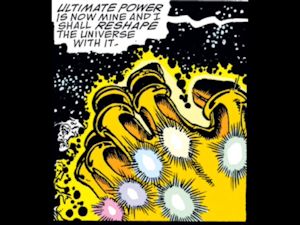 | | Fortunately, his imagination is as limited as his attention span |
The Infinity Gauntlet starts with Thanos already in possession of all six Infinity Gems, which he acquires pretty rapidly in two precursor comics called The Thanos Quest. The locations of the gems in the comics are very different than the locations of the stones in the MCU thus far, and it will take some doing for Thanos to collect them all in a short span of time. (There are six MCU movies coming out before Avengers: Infinity War, Part I, so I'm personally hoping that Thanos gets a single stone in a post-credits scene in each.) In all likelihood, Thanos will have to acquire one or more of them at the start of Infinity War. It's even possible--though I hope it's not the case--that Infinity War, Part I will cover Thanos getting the stones and Infinity War, Part II will be the adaptation of The Infinity Gauntlet. Regardless, it's something we'll have to see on screen. Three of the stones shouldn't be too difficult for Thanos--one in Asgard's vault, one in the hands of the Collector, and one being held by the Nova Corps--but the one in Vision's forehead might be especially tricky. Then there's the Time Stone and Soul Stone, neither of which we've seen in the MCU to date (though Kevin Feige has all but confirmed that Dr. Strange's famous relic, the Eye of Agamotto, will possess the Time Stone). Thanos has a lot of work to do to get ready, is what I'm saying, as does Marvel.
-e. magill 4/7/2016
|
|